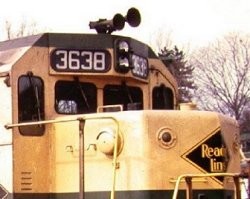EMD: GP35
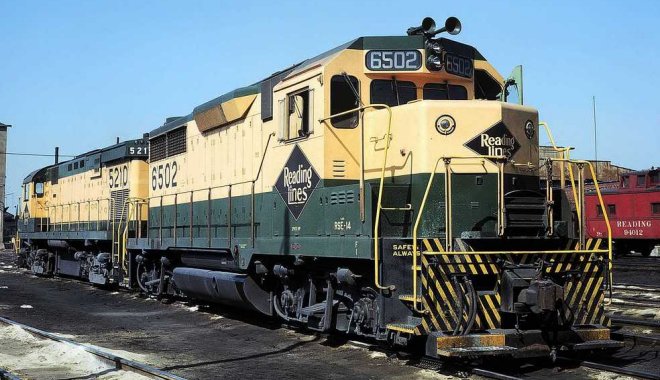
The 2500 horsepower GP-35 was the successor to the GP-30. With 37 units, the GP-35 represented the largest class of second-generation locomotive on the Reading. The first group of GP-35s was a fleet of 6 locomotives that were delivered to the Reading in December, 1963, and were originally numbered 6501-6506. This numbering corresponded with the GP-30s being numbered in the 5500 series - since the GP-35s were of higher horsepower, the first digit was increased to a 6. However, in the latter half of 1964, the Reading created a Power Bureau in conjunction with the B&O and C&O, and this group, along with the GP-30s, were renumbered into the 3600 series to be consistent with the B&O/C&O fleet. The GP-30s were renumbered to 3600-3619, while the first group of GP-35s were renumbered to 3620-3625. As was done with the GP-30s, to offset the costs of these new locomotives, the Reading traded in several F3s: "A" cab units 261, 263, 264, 265, and "B" units 260 and 261.
The next 12 locomotives, numbered 3626 through 3637, were delivered in August 1964, with 18 additional units numbered 3638 through 3655. To aid in financing of these additional units, the Reading traded in all remaining F3s and F7s, so by August 1964, all cab units were gone from the railroad (although many of their parts lived on in the new locomotives) with the exception of the remaining FP7s. The final Reading GP-35 was numbered 3656, and was acquired in May, 1965 through a trade-in of Reading GP-7 663, which was retired 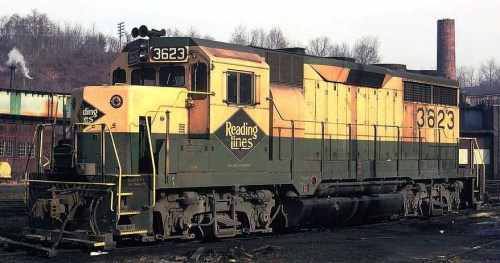 after falling into the turntable pit at the Saucon Creek Enginehouse.
after falling into the turntable pit at the Saucon Creek Enginehouse.
Since they were so numerous, they could be found in service all over the system, from Philadelphia to the Coal Regions. Whether running in multiple hauling mainline through trains, or operating alone on a branchline local, the GP-35s quickly became the mainstay of the Reading's second-generation locomotive fleet, even operating in passenger service in the Philadelphia commuter area during transit strikes or catenary power outages!
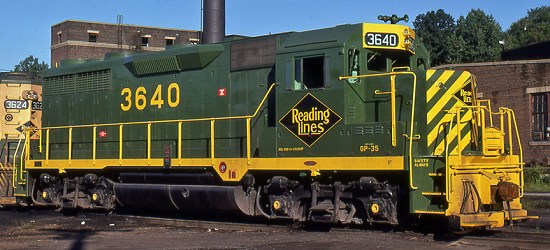
In April, 1974, a comprehensive rebuild was performed on Reading GP-35 #3640, at which time it was painted into the "Reading Green" paint scheme. This unit was the only GP-35 to wear this paint scheme, and it bore a strong resemblance to the road's GP39-2 and GP40-2 locomotives.
MODELING NOTES: When developing your Reading locomotive fleet, maintaining the proper balance among locomotive types will enhance the realism of your roster. Since they were so numerous on the prototype, it would be appropriate to have several GP35s on your layout if you're modeling the time period from 1964 on. Also, as noted in the above text, the cab units and GP35s co-existed in a very narrow timeframe, so while it's reasonable to mix cab and hood units within that window, if you're aiming for historical accuracy, pay close attention to the road numbers in order to reflect which F-units were traded in for the first lot of GP-35s, vs the remainder that were traded in for the final batch. Operationally, these were the Reading's "maid of all work" locomotives, so they could be seen all over the system pulling all types of trains. One final notable "construction" detail - #3638 was fitted with an electronic bell on the engineer's side of the short hood in 1968, as seen in the detail photo below.
|
|
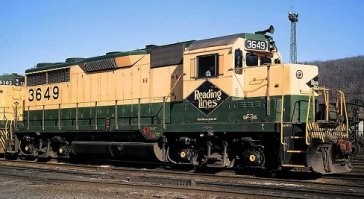 |
Did You Know?
Downloads
 A variety of Reading Company operations related documents, etc. that may be of use in your modeling efforts.
A variety of Reading Company operations related documents, etc. that may be of use in your modeling efforts.
 A variety of Reading Company operations paperwork, such as train orders, clearance forms, etc. that will help you operate your Reading layout in a prototypical manner.
A variety of Reading Company operations paperwork, such as train orders, clearance forms, etc. that will help you operate your Reading layout in a prototypical manner.
 Public Timetables, Employe Timetables, and Rulebooks that provide much useful operational information.
Public Timetables, Employe Timetables, and Rulebooks that provide much useful operational information.
 Signs, billboards, and other FREE goodies for your use. We ask only that you help spread the word about The Reading Modeler!
Signs, billboards, and other FREE goodies for your use. We ask only that you help spread the word about The Reading Modeler!

